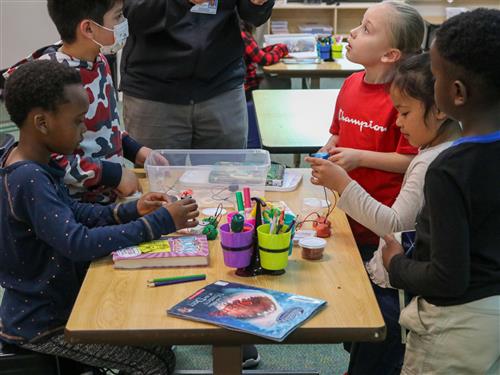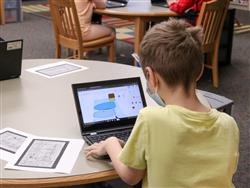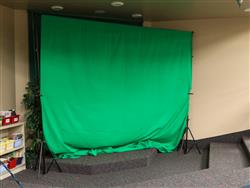- Spokane Public Schools
- More SPS Stories
Elementary students learning advanced technology in ‘the everything place’
Posted by Communications Staff on 4/18/2022 5:00:00 AM

Walk into any SPS elementary school library and you’ll notice the traditional array of books for all grades. But you might also see kids using technology to inspire learning for the 21st century.
At Woodridge, for example, fourth graders are using computer-aided design (CAD) software to design boats. Regal students are creating stop-motion animation videos using Legos, while first graders at Grant are creating electrical currents using Squishy Circuits (pictured above).
That’s life in the modern-day library, and Jeremy Klingback at Woodridge Elementary is taking advantage. Klingback, the school’s library information specialist, lights up when talking about the cool things happening in his domain.
“It’s the everything place. When I think of libraries and when I first came here, I kind of had that traditional model where it was books, it was reading, checking out a book and go home,” Klingback said. “I think that served a purpose for a while, but things have changed. Technology is a more important part of our lives and a bigger part of our lives. Having a space where you have access to those resources and those materials and training is just another part of what a library should be.” 
Klingback understands that kids nowadays know how to use various forms of technology at greater ease than many of their parents and grandparents. It’s a sign that introducing technology like video editing and CAD can be effective in creating 21st century learners.
“People talk about learning a second language. I tried to do it when I was older and it was really hard,” Klingback said. “These kids are doing it while they’re young and their brains are very malleable and like sponges, they can just absorb the new language and it’s easy for them. Technology is kind of the same thing, it’s a new language. When they’re young and exposed to these things responsibly, they suck it right in. It’s amazing.”
Klingback said he started the year planning to just teach tech to sixth graders. But once he realized the students were mastering it so quickly, he decided to introduce the technology to fifth graders. Then, the same thing happened, so he introduced it to fourth graders, with some students going home and creating things on their own. He’ll soon begin teaching the basics of CAD to third graders, who are already learning video editing skills.
Klingback mirrors the work in his library to what the students are learning in their classroom.
When sixth graders were learning about ancient Greek history in their classroom. Klingback had them research ancient Greek art and artifacts. Then they used CAD software to design their own ancient Greek architecture.
 Another class was completing a science unit on climate. In the library, they researched different regions of the world and created video presentations using a green screen.
Another class was completing a science unit on climate. In the library, they researched different regions of the world and created video presentations using a green screen.
“Instead of holding up a piece of paper and reading an essay, they were able to create this awesome video that gathers people’s attention, and they can get across everything they want in such a unique way,” Klingback said. “These are the things they’ll need to know later on. A lot of them might get into jobs like this, so the fact that we can expose this to them at a young age, like a new language, is just going to help them as they get older.”
Fourth graders were learning about the Lewis & Clark journey, so they researched different modes of transportation from that era and designed wooden boats using CAD software.
The library will always be a place for reading, literacy and discovery, but Klingback and his colleagues are transforming library time to meet the needs of a 21st century workforce.
“They can come in and read books, they can do their research, and they can also come here and have a whole new world opened up,” Klingback said. “When I say it should be the everything place, it’s where they can take their learning in the classroom and bring it here and go deeper.”
Recent
By Month
- April 2024
- March 2024
- February 2024
- January 2024
- November 2023
- October 2023
- September 2023
- August 2023
- July 2023
- June 2023
- May 2023
- April 2023
- March 2023
- February 2023
- January 2023
- December 2022
- November 2022
- October 2022
- September 2022
- August 2022
- July 2022
- June 2022
- May 2022
- April 2022
- March 2022
- February 2022
- January 2022
- December 2021
- November 2021
- October 2021
- September 2021
- August 2021
- July 2021
- June 2021
- May 2021
- April 2021
- March 2021
- February 2021
- December 2020
- November 2020
- October 2020
- March 2020
- November 2019
- October 2019
- May 2019
- April 2019
- February 2019
- January 2019
- November 2018
- October 2018
- September 2018

